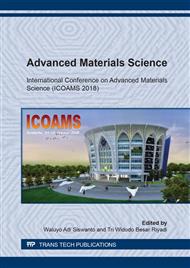p.80
p.91
p.97
p.107
p.112
p.118
p.126
p.137
p.148
Hardness Optimization Based on Nitriding Time and Gas Pressure in the Plasma Nitriding of Aluminium Alloys
Abstract:
Plasma nitriding has attracted much interest to improve the hardness of aluminium alloys. However, the contradictive properties can be produced on the metal surface due to the saturated condition of the diffused nitrogen atom in the metal surface layer. The objective of this work was to investigate the effect of nitriding time and gas pressure to improve the hardness of aluminium using plasma nitriding. The nitriding processes were conducted in a DC glow discharge with nitrogen gas flowing inside the vacuum chamber. Firstly, the sample was nitrided using a fixed gas pressure of 1.2 mbar with the varied nitriding times of 3, 4, 5 and 6 hours. The optimum time producing the highest hardness of the surface was then used in the next nitriding process with varied gas pressure of 1.2, 1.4, 1.6 and 1.8 mbar (1 bar = 105 Pa). The optimum gas pressure producing the highest hardness was then used again in the last nitriding process using varied nitriding time of 3, 4, 5 and 6 hours. The result showed that the highest hardness was achieved using the gas pressure and nitriding time of 1.6 mbar and 4 hours, respectively. The formed AlN phase on the aluminium surface was identified by XRD, whereas the surface morphology was observed by SEM image. Compared to the untreated sample, the hardness of the treated samples was significantly high.
Info:
Periodical:
Pages:
112-117
Citation:
Online since:
July 2019
Keywords:
Price:
Сopyright:
© 2019 Trans Tech Publications Ltd. All Rights Reserved
Share:
Citation:


